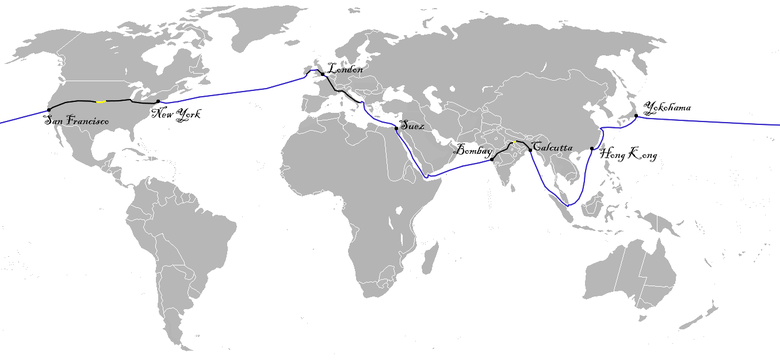“Around the World in 80 Days” is a classic adventure novel written by Jules Verne tells the story of Phileas Fogg (and his French valet Passepartout) who attempt to circumnavigate the globe in 80 days. The book which was published in 1873, and is a rip-roaring adventure set primarily in Victorian England. It highlights how technology was advancing rapidly during this period. Railway became a travelling standard which in turn increased global tourism. It inspired people to easily set a schedule, book tickets and travel around the world, which wasn’t common during the Victorian era.
Wanna bet?

In the story by Jules Verne, Fogg gets into an argument with his fellow members At the Reform Club over an article in The Daily Telegraph. The article stated that with the opening of a new railway section in India, it is now possible to travel around the world in 80 days. He accepts a wager for £20,000 (which would be equal to about £1.5 million today) from his fellow club members, which he will receive if he makes it around the world in 80 days.
He left London with his French valet Passepartout and followed the route given as follows:

London, the UK to Suez, Egypt
The original itinerary of the book takes Phileas Fogg and his valet Passepartout from London to Suez (Cairo) by taking the Orient Express train. They travel across France and the Alps to reach Venice. Here, they move on to Brindisi (Italy) where they change to a steamer that brings them across the Mediterranean Sea. This takes 7 days.

Suez to Bombay, India
From Suez (Cairo) to Mumbai, Fogg and Passepartout disembark in a steamer across the Red Sea and the Indian Ocean. During this journey, they are watched by a Scotland Yard detective, Inspector Fix. Because Fogg matches the description of a bank robber Fix is looking for, he mistakes Fogg for the criminal. Fogg promises the steamer engineer a large reward if he gets them to Bombay early. They dock two days ahead of schedule. This takes a total of 13 days.
Bombay to Calcutta, India
After reaching India, they take a train from Bombay (now Mumbai) to Calcutta (Kolkata) which takes 3 days. Here, Fogg learns that the Daily Telegraph article was wrong—the railroad ends at Kholby and starts again 50 miles further on at Allahabad.
In this journey, they meet a young Indian woman called Aouda, who is led to a sanctuary where she is to be sacrificed according to the rite of Sati (suicide on her husband’s funeral pyre) the next day. They rescue Aouda and bring her along on their journey. Even after this rescue operation, Fogg reaches Allahabad for the train ( Via elephant ride).
Obviously now, you don’t get to purchase and ride elephants for your personal transport like that.

Calcutta to Hong Kong and Hong Kong to Yokohama, Japan
For Kolkata to Hong Kong, the travellers catch a steamer going to Hong Kong across the South China Sea which takes 13 days.
Here Fix gets Fogg and Passepartout arrested. Although they jump bail, Fix follows them to Hong Kong. Since without a warrant, he decides that his last chance would be to arrest Fogg on British soil. Fix confides in Passepartout but to prevent Passepartout from informing his master about the premature departure of their next vessel, Fix gets Passepartout drunk and drugs him. Due to this, Passepartout neglects to inform Fogg about the early steamer but manages to catch it himself.

After missing his early ride, Fogg manages to find another steamer headed for Yokohama. Steamer across the China Sea and the Pacific Ocean takes the travellers from Hong Kong to Yokohama (Japan) in 6 days. They are united with Passepartout (who arrived early) in a circus, trying to earn the fare for his homeward journey.
Yokohama to San Francisco, United States
It takes another 22 days for Phileas and Passepartout to travel from Yokohama (Japan) to San Francisco (USA). They take a steamer across the Pacific Ocean for this journey. Fix promises Passepartout that now, he will no longer try to delay Fogg’s journey.
San Francisco to New York City, United States
In San Francisco, they board a transcontinental train to New York which takes another 7 days. During this journey, they encounter a number of obstacles such as a massive herd of bison crossing the tracks, a failing suspension bridge, the train being attacked by Sioux warriors, uncoupling the locomotive from the carriages and Passepartout being kidnapped by the Indians (but Fogg rescues him). They continue by a wind-powered sledge to Omaha, where they get a train to New York.

New York to London
From New York, he finds another steamer to cross the Atlantic Ocean but the steamboat was destined for Bordeaux, France and the captain refused to take them to Liverpool. Fogg manages to bribe the crew to change its course for Liverpool against the captain’s wishes. However, when the ship runs into bad weather and runs out of coal, Fogg has to buy the ship from the captain. They burn the wooden parts of the ship as fuel, though it was only enough to get them as far as Queenstown (Cobh), Ireland.
From here, they take an express mail train to Dublin followed by a fast boat to Liverpool. Sadly at Liverpool (as they have reached the British soil), he is arrested by Fix. The misunderstanding is cleared up (the actual robber was caught three days earlier in Edinburgh) and Fogg returns to London five minutes late, certain that he lost the bet. It takes them 9 days to reach London from New York.
But as the party travelled eastward and gained a day, the wager is won by Phileas Fogg!
In the 21st century, however, it seems pretty easy peasy with the round-the-world (RTW) tickets, doesn’t it? While this classic journey took 80 days, today the fastest route can be even less than 80 hours.

Yes, No Kidding! Now, your own “Around the world in 80 Days” depends on what you want to do. Do you want an active, adventure-focused experience? Or would you prefer seeing the magnificent landscapes? Above all, it is to be kept in mind that most RTW tickets involve flying in and out of major hubs which of course will increase the cost of the ticket considerably. So, pick a plan that not just suits your needs but is also easy on the pocket.
Keep the bubbling spirit of adventure alive and replicate the route from Around the World in 80 Days to be the ‘Phileas Fogg’ of the 21st century.
Also Read: Following The Trail Of The Odyssey In The Modern Day


